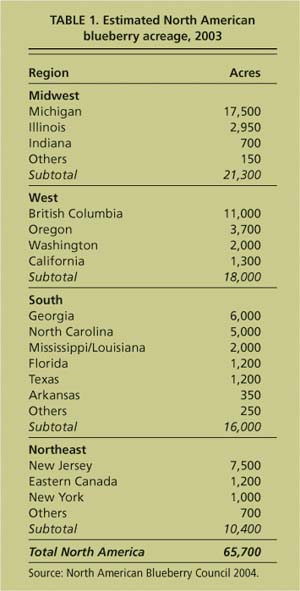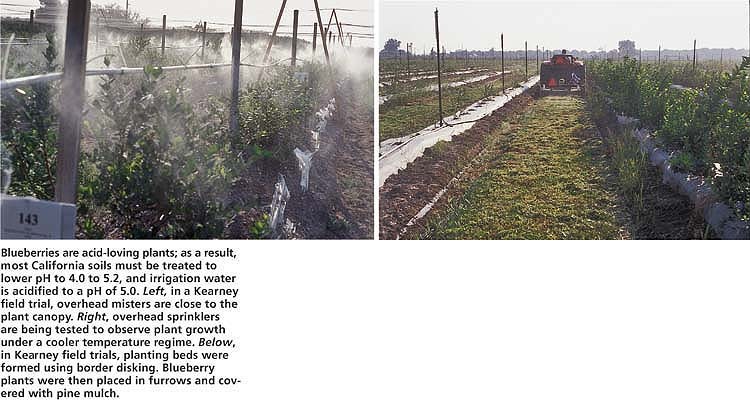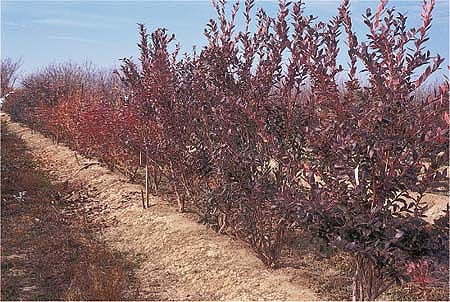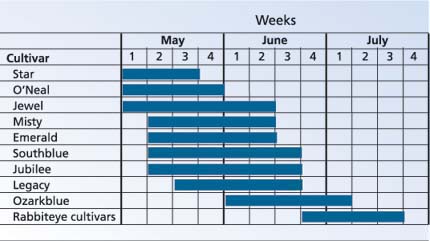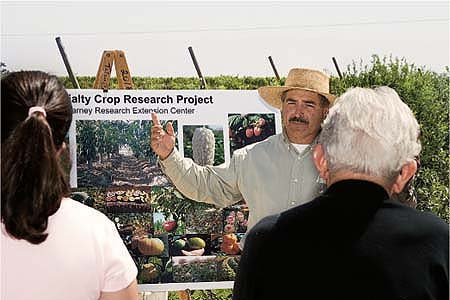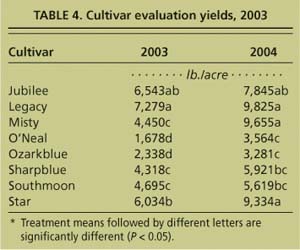All Issues
Blueberry research launches exciting new California specialty crop
Publication Information
California Agriculture 59(2):65-69. https://doi.org/10.3733/ca.v059n02p65
Published April 01, 2005
PDF | Citation | Permissions
Abstract
Observational trials at the UC Kearney Research and Extension Center indicate that new southern highbush blueberry cultivars, which require fewer “chill hours” to produce fruit, are well adapted to the San Joaquin Valley climate. In a replicated cultivar evaluation, we quantified yields and identified several productive and flavorful varieties. These initial trials and ongoing studies on irrigation, plant spacing, mulches and pruning will improve the likelihood of establishing this promising new crop in the semiarid valley. Because blueberries are acid-loving, the soil must be extensively treated before planting, at considerable expense. Growers considering planting or expanding blueberry acreage should develop sound business plans, accounting for lower future prices and improved growing, harvesting and packing efficiencies.
Full text
Due to overproduction, market prices for many crops have been depressed for several years, resulting in the removal of thousands of acres of citrus, stone fruits, grapes and olives in the San Joaquin Valley. More than ever, growers are seeking new crops to plant, and many are focusing their attention on specialty or alternative crops. Observational trials indicate that new southern highbush blueberry cultivars are well adapted to San Joaquin Valley conditions. These initial trials and other ongoing studies will improve the likelihood of establishing this crop in the semiarid valley, a region not traditionally known for blueberries. However, prudence is appropriate, since blueberries are one of the most costly crops to establish. Blueberry establishment and production costs can exceed $10,000 per acre, and blueberries require significantly more management than most other specialty crops (Bervejillo et al. 2002). The objective of current UC blueberry research is to develop sound information for selecting cultivars and to verify production practices that will assist growers in establishing blueberries.
Blueberries historically have been grown mostly in the cooler regions of the United States. The recent development of new low-chill cultivars such as ‘Legacy’, above, in concert with innovative growing techniques and strong consumer demand have created an important specialty crop for the San Joaquin Valley.
Blueberry is a member of the family Ericaceae, which includes woody shrubs such as azaleas and rhododendrons that grow well in acidic soils. Highbush blueberries are woody, shallow-rooted perennial shrubs. Although some species grow taller than 20 feet, most cultivars are 4 to 10 feet tall at maturity. In established growing regions, plants reach full production within 6 to 8 years and can remain productive for 20 years or more. Proper pruning, mulching and pest monitoring are essential to maintain plant vigor and productivity. The San Joaquin Valley's warm winters and hot summers appear to hasten plant development, but could also impact longterm blueberry productivity.
Highbush blueberries (Vaccinium corymbosum) and low-bush blueberries (Voccinium angustifolium) are important commercial types and are native to the northeastern United States. Rabbiteye blueberries (Vaccinium ashei) are also produced commercially and are native to the southeastern United States.
The terms “northern highbush” and “southern highbush” refer to the chilling requirement of blueberry cultivars. Chilling is the accumulated number of hours between 32°F and 45°F that are necessary for a dormant plant to break vegetative and flower buds. Most northern highbush cultivars require more than 1,000 chill hours for bud-break (Gough 1991). Chill hours in the San Joaquin Valley range from 600 to 1,200 annually. Previous failures at establishing blueberries in California's warm climate were mostly due to the utilization of northern highbush cultivars, which were poorly adapted to the mild winters of the San Joaquin Valley. Breeders in the southeastern United States have developed “low-chill” southern highbush cultivars by crossing northern highbush species with native Florida species. These low-chill cultivars require only 150 to 600 chill hours for bud-break (Gough 1991).
Growers who are considering planting blueberies or expanding current acreage must develop sound business plans to anticipate market changes and production improvements. Morten Johnson, a Kingsburg dentist and former KREC committee member, attended an open house held for UC president Robert C. Dynes, and learned about new blueberry varieties at the center's research plot.
North American production areas
Until recently, blueberries were grown almost entirely in the cooler regions of the United States including Michigan, New Jersey, Oregon and Washington, where winter climates and the natural acidic soils were uniquely suited for blueberry production. However, with the development of improved low-chill cultivars from the 1970s through the 1990s, blueberry production has expanded to the southern United States and now, California.
Increased consumer demand is driving the market for fresh blueberries, making them a potentially lucrative specialty crop. Furthermore, reports on the health benefits of blueberries have contributed to worldwide consumer interest (US Highbush Blueberry Council 2003). Blueberry acreage in North America has increased over the last decade and considerably more so during the last 5 years. In 2003, blueberry acreage in North America exceeded 65,000 acres (North American Blueberry Council 2004) (table 1). Production and disposition figures for 2003 show that 69% of the blueberry crop was for fresh utilization rather than processing, further illustrating the consumer demand-driven market that blueberries currently enjoy (table 2).
Fig. 1. State blueberry harvest periods that overlap with California's. Source: Agricultural Marketing Service 2003.
The North American harvest usually begins in Florida in early April and concludes in Michigan and British Columbia in early October (Agricultural Marketing Service 2003). The California harvest typically begins in early May and lasts almost 8 weeks (fig. 1). Furthermore, the arrival of low-chill cultivars has expanded global plantings to Chile, Argentina and tropical Colombia, thereby ensuring fruit availability even during the winter in North America.
Planting considerations
Blueberries are acid-loving plants; therefore, most California soils must be acidified for successful plant establishment. The optimum soil pH for blueberry culture is 4.0 to 5.2 (Strik et al. 1993). Soil acidification is most often achieved using sulfuric acid, which is broadcast over the surface of the soil and then flood irrigated with sufficient water to incorporate it to a depth of 12 inches. Soil sulfur can be applied but may require several months to convert to sulfate and change the soil pH. Sulfur is not as predictable as sulfuric acid for changing soil pH. Therefore, when applying sulfur, additional attention must be given to monitoring soil pH and making appropriate adjustments. Citric acid and other acidic compounds may be used to lower soil pH, but they are more costly.
Poor water quality also affects blueberry plant growth. Many agricultural water sources contain high levels of bicarbonates (Gregory 2001; Gaskell 2002). Bicarbonates raise pH and affect the uptake of nutrients by blueberry plants. Additionally, bicarbonate content greater than 1.5 to 2.0 milligrams per liter can cause the precipitation of calcium or magnesium carbonate, resulting in a chalky deposit that plugs drip and microjet irrigation systems (Gregory 2001). The installation of acid injection equipment may be required to maintain acidic conditions in the irrigation water. Water samples should be tested to determine if treatment is needed. Sulfuric acid (93% to 98% acid) and urea sulfuric acid (27% to 55% acid) are the most common acidifying agents for irrigation water; however, phosphoric acid (52% to 54% acid) and citric acid can also be used (Gregory 2001). Soil sulfur, acetic acid (vinegar) and citric acid are the only acidifiers that are acceptable for organic blueberry production. The approximate cost of acid materials ranges from approximately $1.00 to $4.00 per gallon, with sulfuric acid being the least expensive and highest in percentage active ingredient. All acids are potentially hazardous materials and considerable care must be taken to minimize worker exposure and maintain safe working conditions.
The broadcasting of acids to the soil, especially sulfuric acid, is performed by companies specializing in the transportation of hazardous materials and custom application of acids, using specialized application equipment. Once the acid is applied to the soil, followed by an irrigation, the acid reacts with calcium carbonate in the soil and does not present a hazard. The application of sulfur and other sulfur-based soil amendments is a common practice in high calcareous western soils. Depending on the buffering capacity of the soil, the acid is converted, neutralized and used within several inches from where it is applied on the soil. The soil reaction is summarized as: sulfuric acid plus lime gypsum plus carbon dioxide plus water. What is unique about blueberries is that a lower pH is desirable for optimum plant vigor than for any other commercial crop.
Blueberry cultivar studies
Trial I
We initiated blueberry observation trials at the UC Kearney Agricultural Research and Extension Center (KREC) in Parlier in 1997, which have provided insight to key characteristics of numerous blueberry cultivars. The results of these trials indicated that southern highbush blueberry cultivars are well adapted to the San Joaquin Valley. We identified several key, earlyseason cultivars that will likely form the basis for the young industry that is developing in the state (table 3).
Field trials showed that Southern highbush blueberry cultivars are well adapted to the San Joaquin Valley. These new cultivars, such as ‘Reveille’, above, begin flowering in late winter and open a harvest window from early May through the Fourth of July.
Blueberries are acid-loving plants; as a result, most California soils must be treated to lower pH to 4.0 to 5.2, and irrigation water is acidified to a pH of 5.0. Left, in a Kearney field trial, overhead misters are close to the plant canopy. Right, overhead sprinklers are being tested to observe plant growth under a cooler temperature regime.
Nearly all the cultivars established at KREC were started from tissue culture and then grown for two seasons by Fall Creek Farm and Nursery in Lowell, Ore. Currently, more than 50 cultivars are under observation at KREC. Although the data does not provide information on fruit quality attributes, it is important to call attention to ‘Southmoon’ and ‘Reveille’, a couple of cultivars that produce outstanding fruit quality and are well suited for direct sale to consumers. Although ‘Reveille’ does not produce large fruit and both cultivars are less productive than others, their sweetness and firmness are distinct and may result in consumer preference and consistent return purchases.
In Kearney field trials, planting beds were formed using border disking. Blueberry plants were then placed in furrows and covered with pine mulch.
Trial II
In 2001, a multipurpose replicated trial was established at KREC. Prior to establishing the blueberry trials, the 2-acre field was fumigated to kill the nut grass (Cyperus rotundus) that covered the entire area. In July, a fumigant mixture was applied, 300 pounds of methyl bromide and 100 pounds of chloropicrin per acre. A soil test indicated that the field pH was approximately 7.0. In September, 5 tons of sulfuric acid was broadcast on the surface of the soil using specialized application equipment. The acid was incorporated to a depth of 10 to 12 inches with flood irrigation, resulting in a pH ranging from 5.0 to 5.5. A complete fertilizer (15–15-15) was broadcast applied at a rate of 400 pounds per acre. Rows were set 11 feet apart. Planting beds were formed using border discs, then rolled to pack the soil. A furrow 12 inches wide and 6 inches deep was cut on top of the raised beds.
Blueberry plants were planted in the bottom of the furrow, which was then filled with pine mulch. Two drip lines were placed on the surface of the mulch, one on each side of the plant row. The emitter spacing was 18 inches apart with each delivering 2 liters of water per hour. Irrigation water was acidified to a pH of 5.0 using urea sulfuric acid fertilizer. The trial received 20 pounds of nitrogen (N) per acre from a 32% urea ammonium nitrate solution (UN32) during the first growing season, followed by 60 and 90 pounds of nitrogen per acre utilizing urea sulfuric acid (US15: 15% nitrogen, 16% sulfur, 49% sulfuric acid)(Gregory 2001) in the second and third growing seasons, respectively.
The replicated cultivar evaluation included eight southern highbush cultivars with the exception of ‘Legacy’, which is a northern-southern cross. Early-season cultivars were ‘O’Neal’, ‘Sharpblue’, ‘Misty’ and ‘Star’; midseason cultivars were ‘Legacy’, ‘Jubilee’ and ‘Southmoon’; and the lone lateseason selection was ‘Ozarkblue’. Each treatment included seven plants spaced 36 inches apart. The experimental design was a randomized complete block with four replications.
Fig. 2. Harvest periods for key commercial blueberry cultivars in the San Joaquin Valley. The initiation and termination of harvest will vary as much as 10 days, depending on local weather conditions.
UC small farms advisor Manuel Jimenez is leading the effort to develop sound information for selecting blueberry cultivars and fine-tuning production techniques.
The trial produced a commercial crop in the second growing season. ‘Misty’ and ‘Star’ produced the highest yields among the early cultivars, whereas ‘Legacy’ was the most productive of the midseason-maturing cultivars (table 4). The harvest period for ‘Star’ in 2003 and 2004 began the first week of May and ended after the third harvest 15 days later (fig. 2). ‘Misty’ had the longest harvest interval (5 weeks), beginning the second week of May and terminating the second week of June. The harvest period for ‘Legacy’ lasted 4 weeks, beginning the third week of May and ending during the second week of June. Most other cultivars required five or more harvests, 1 week apart. Yields generally appear to be following the trend of data collected from the observational plots, which are now in their sixth and seventh year of production.
Looking forward
Concomitant with the initiation of the cultivar trial in 2001, several other trials were also established, including an irrigation study, a plant spacing comparison, a mulch evaluation and a pruning study. Although these trials are too young to report upon at this time, forthcoming results will provide critical data that will assist in the establishment of common cultural practices for California blueberries. Several new cultivars have been introduced into the observational collection, and because of their outstanding characteristics, some may actually become more important than those in current use. We are also studying hoop-houses (mobile greenhouses) at KREC, which could potentially hasten or delay fruit maturity so that specific market periods can be targeted. Moreover, other researchers and growers statewide are conducting blueberry research. UC farm advisors Mark Gaskell, Ben Faber and Ramiro Lobo have established trials along the central and southern coast of California, while Abdelaziz Baameur, Calvin Fouche and Mario Moratorio are conducting blueberry research in Northern California. Data is not yet available from these trials.
Since blueberry acreage has increased dramatically to reflect consumer demand, we assume that prices will decline sooner rather than later. Growers who are considering planting or expanding current acreage must develop sound business plans, which account for lower future prices and improved growing, harvesting and packing efficiencies. Staying abreast of technical advances, and establishing and maintaining good marketing relationships are essential to minimize risks. Additionally, California producers should consider taking leadership roles in blueberry marketing and promotion activities and organizations, to sustain blueberry profitability.




